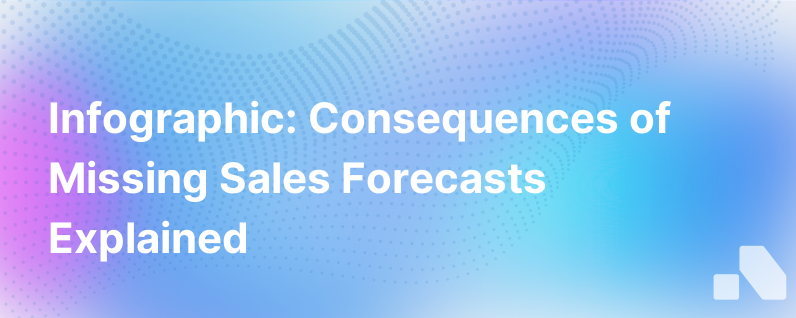Infographic The Impact Of Missing Your Forecast
Published on November 13, 2023 by David Zhang
In the intricate dance of sales and revenue projections, sales forecasts hold the fort as the compass guiding businesses toward strategic decisions, resource allocation, and growth planning. Accurately predicting sales is akin to plotting out a course on a nautical map — vital to reaching one's financial destination. But what happens when those calculations are off? When the needle on the compass deviates from true north?
The impact of missing your sales forecast can be substantial and multi-faceted, affecting almost every aspect of the business. Let's visualize this concept through an exploratory journey, unpacking the potential repercussions with the detailed scrutiny of an infographic.
Initial Turbulence: Stakeholder Confidence and Market Perception
Missing sales forecasts can immediately send shockwaves through the investor community. The graph dips, trust wavers, and the market's perception of your company takes a hit. For public companies, this often results in a decline in share price, reflecting investor concern over the company's performance and long-term profitability prospects.
Shareholders aren’t the only stakeholders who observe these missed milestones with concern. Partners who have tied their expansion and investment plans to the company's projected financial health might re-evaluate their relationship and strategy. The impact here is twofold—a reduction in investor confidence and a potential pullback from partners who might have otherwise invested in joint ventures or market expansion initiatives.
Cascading Effects: Operational Consequences
Delve into the operational layers, and you’ll find a deep-seated impact. Inaccurate sales forecasts disrupt the supply chain equilibrium. A pie chart slices up the areas of inventory management, production planning, and workforce allocation, highlighting how each segment spirals from the center of forecasting inaccuracies.
An overestimation leads to excess inventory—a visual bar of stocked products high above the optimal line—translating to higher holding costs and potential waste. A similar bar for staffing would peak above the optimal line in anticipation of high sales volume that never materializes, resulting in overstaffing and increased labor costs.
On the flip side, if there's an underestimation of sales forecasts, the bars fall short. Stockouts and capacity constraints rear their heads, not only causing revenue loss from unmet customer demand but also damaging customer relationships and brand reputation — the latter represented by a diminishing brand loyalty meter in the corner of the infographic.
The Strategic Stumble: Planning and Growth Implications
Growth strategies rely heavily on accurate forecasting; hence, missing these critical numbers can stifle a company’s strategic momentum. Expansion plans, marked boldly on our infographic’s timeline, get delayed or scrapped due to a lack of capital or uncertain market conditions.
In this segment of the infographic, we place special emphasis on innovation and development — sectors that suffer when forecasts are off. Curved lines depicting the innovation pipeline now have breaks or gaps. The anticipated revenue was the lifeline expected to fund these projects, and without it, there's potential delay or stagnation.
Financial Flows Disrupted: Revenue and Profitability
At the heart of this infographic, the winding river of revenue narrows and bends unpredictably. Illustrative charts show declining sales and the direct hit to profitability, with profit margins compressing under the weight of unanticipated costs and missed revenue opportunities.
A side box details the consequent financial pressures—increased borrowing, interest expenses, or the need for additional equity financing to cover the shortfall, each with its own set of implications and dilutive effects on current ownership.
Corporate Culture and Morale: The Human Impact
Beyond numbers and strategy lies the human element. Missing sales forecasts can dampen the spirit across teams. Employees, represented as stick figures with drooped shoulders, reflect the drop in morale. This section of the infographic demonstrates how sales teams, in particular, can become demotivated, leading to lower productivity and increased turnover rates.
Speech bubbles with dashed lines indicate the silencing effect on communication and transparency as management becomes wary of sharing 'bad news.' A cohesion graph shows a downward trend, portraying the internal disconnect that can arise from missed targets.
Navigating Back to True North: Mitigation and Adaptation
The final section of our infographic looks toward the horizon. Arrows and signposts point to mitigation strategies—tighter forecasting methods, agile decision-making frameworks, and diversified revenue streams. We overlay this with a resilience meter showing incremental improvement as these strategies take root.
An accompanying checklist emphasizes the need for robust data analytics, enhanced communication channels, and a culture that embraces both successes and learning opportunities from misses.
In Summary
The infographic culminates with a powerful message: While the impact of missing sales forecasts is extensive, permeating through every operational vein of the business, it also presents an opportunity for recalibration, learning, and growth.
In the world of sales and projections, navigating through the fog of uncertainty is a given. The true test lies in how a company adjusts its sails to the changing winds, captures the learnings from the variance in forecasts, and steadies its course back towards success.
For a detailed view and further insights into mitigating the impact of missed sales forecasts, leverage comprehensive tools like Aomni that streamline your sales processes and provide real-time, actionable data to keep your sales targets on track.